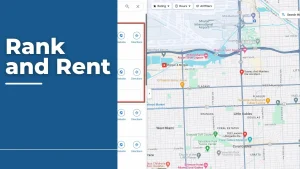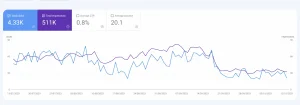Key Takeaways
- Duplicate content is a major issue in Shopify, including duplicate product pages and collections pages.
- Adjusting the internal linking structure in Shopify can help point to canonical URLs and avoid conflicting signals for search engines.
- Pagination in Shopify can create duplicate content, and the first paginated result should point to the canonical page.
- Implementing structured data, such as Product structured data and Breadcrumb List structured data, can improve website structure understanding.
Looking to boost your Shopify website’s visibility and improve its SEO? Look no further! Get our Ecommerce SEO Service.
In this comprehensive guide, we’ll walk you through the essential strategies and recommendations for optimizing your Shopify site to rank higher in search engine results.
With Shopify’s growing popularity, it’s crucial to address common SEO issues specific to the platform.
We’ll show you how to tackle challenges like duplicate content and non-canonical URLs head-on.
By removing duplicate URLs, creating engaging blog content, and implementing structured data, you’ll enhance your website’s visibility and attract more organic traffic.
We’ll also delve into the importance of keyword research and optimization for title tags, meta descriptions, and URLs.
Plus, we’ll highlight the power of adding unique product descriptions and leveraging informational content through a blog.
Don’t forget to optimize site performance and utilize Shopify’s SEO apps for maximum impact.
Get ready to optimize your Shopify website and boost your rankings with this comprehensive guide!

Shopify SEO Overview
If you want to optimize your Shopify store for better SEO, it’s important to have an understanding of Shopify SEO.
This includes the platform’s unique challenges such as duplicate content, non-canonical URLs, and pagination issues.
To implement effective Shopify SEO strategies, you should follow best practices for optimizing Shopify.
This includes removing duplicate URLs, creating blog content, and adding structured data.
Duplicate content is a major issue created by Shopify, with duplicate product pages and collections pages being common problems.
The default internal linking structure in Shopify also creates non-canonical URLs, which can confuse search engines.
Pagination in Shopify can lead to duplicate content, so it’s crucial to ensure that the first paginated result points to the canonical page.
Additionally, having multiple URLs for the same product with slight variations can create duplicate content, so it’s important to consider the benefits and uniqueness of variant URLs.
Overall, by understanding these challenges and implementing you can optimize your Shopify store for better SEO.
Platform Popularity
With its usage doubling since October 2017, Shopify has become a rising star, capturing the hearts of online retailers across the globe like wildfire.
Shopify’s growth in popularity in recent years has had a significant impact on SEO strategies.
As more and more businesses choose Shopify as their e-commerce platform, it becomes crucial to understand how this popularity affects search engine optimization.
With a larger number of websites using Shopify, competition in search engine rankings becomes more intense.
This means that SEO strategies need to be more targeted and effective to stand out in the crowd.
As a result, businesses need to stay updated on the latest SEO techniques and best practices specific to the Shopify platform to ensure their websites rank high and attract the right audience.
Common Recommendations to Optimize your Shopify store
To improve your website’s visibility and rankings, make sure to implement common recommendations for optimizing your Shopify store.
One important aspect of Shopify SEO is creating blog content.
Adding a blog to your store not only provides valuable information to your customers but also allows you to target specific keywords and increase your chances of ranking in search engine results.
In addition, optimizing your product descriptions is crucial for Shopify optimization.
Make sure to write unique and user-focused descriptions for each product, incorporating target keywords and following on-page best practices.
This will not only improve your chances of ranking in search engine results but also provide valuable information to your customers, increasing their likelihood of making a purchase.
Implementing these steps for blog content and product descriptions will help you optimize your site for better SEO results and ultimately drive more traffic and conversions to your website.
| Benefits of Blog Content for Shopify SEO | Steps for Optimizing Product Descriptions on Shopify |
| – Target specific keywords | – Write unique and user-focused descriptions |
| – Increase chances of ranking | – Incorporate target keywords |
| – Provide valuable information to customers | – Follow on-page best practices |
| – Drive more traffic and conversions | – Improve chances of ranking in search results |
Dealing with Duplicate Content
When dealing with duplicate content on your Shopify store, it’s important to address the issue to improve your website’s visibility and rankings.
Handling duplicate content is crucial for effective SEO.
One of the common issues created by Shopify is duplicate product pages and collections pages.
This can confuse search engines and dilute the ranking signals.
To manage duplicate content, you can adjust the internal linking structure to point to canonical URLs.
Additionally, pagination in Shopify can create duplicate content, so make sure the first paginated result points to the canonical page.
Shopify stores often have multiple URLs for the same product with slight variations, which also creates duplicate content.
It’s essential to evaluate whether variant URLs are beneficial based on customer queries, content uniqueness, and available resources.
By implementing these strategies for duplicate content management, you can enhance your SEO for Shopify.

Adjusting Internal Linking
Adjusting the internal linking structure in your Shopify store is crucial for optimizing your website’s SEO performance.
By optimizing internal links, you can improve the overall website structure, making it easier for search engines to crawl and index your pages.
Start by reviewing your current internal linking structure and identifying any non-canonical URLs that may be causing conflicting signals for search engines.
Adjust these links to point to the canonical URLs to avoid duplicate content issues.
Additionally, ensure that your pagination is set up correctly, with the first paginated result pointing to the canonical page.
Finally, address any duplicate content created by having multiple URLs for the same product with slight variations.
Evaluate whether these variant URLs are beneficial for customer queries and unique content, and make adjustments accordingly.
By optimizing your internal linking structure, you can improve your Shopify store’s SEO and enhance your website’s overall performance.
Managing Pagination
Improve your Shopify store’s SEO performance by effectively managing pagination and avoiding duplicate content issues.
Implementing pagination best practices is crucial to optimize your crawl budget for Shopify stores.
Here are a few tips to help you get started:
- Use rel=‘next’ and rel=‘prev’ tags in your paginated pages to indicate the relationship between them.
- Ensure that the first paginated result points to the canonical page to avoid duplicate content.
- Set a maximum number of pages in your pagination to prevent excessive crawling.
Managing pagination properly not only improves the user experience but also helps search engines understand the organization of your content.
By implementing these best practices, you can ensure that your Shopify store is efficiently crawled and indexed, leading to better visibility and higher rankings in search engine results.
Handling Variant URLs
To handle variant URLs on your Shopify store, you need to consider customer queries, unique content resources, and the uniqueness of the content itself.
Managing duplicate product pages is crucial to avoid duplicate content issues.
Shopify stores often have multiple URLs for the same product with slight variations, which can create confusion for search engines.
However, whether variant URLs are beneficial depends on the specific customer queries and the availability of resources for unique content.
It’s important to optimize your Shopify blog functionality as well.
Adding a blog to your store allows for the creation of informational content, which Google is starting to prefer over purely transactional content.
By incorporating targeted keywords and providing valuable information, you can improve your chances of ranking higher in search engine results.
Crawling and Indexing on Shopify
Now that you’ve learned about handling variant URLs on Shopify, let’s move on to the next important topic: Crawling and Indexing on Shopify.
When it comes to optimizing your Shopify store for search engines, it’s crucial to prevent duplicate content issues and optimize your crawl budget.
Duplicate content can harm your SEO efforts, so it’s important to address it.
Shopify has unique SEO items for crawling and indexing, including the default robots.txt file.
You can update the robots.txt file by creating a robots.txt.liquid file and adding custom rules.
Additionally, optimizing your crawl budget is essential to ensure that search engines can efficiently crawl and index your site.
By following the best steps and making necessary adjustments, you can improve the crawling and indexing of your Shopify store, ultimately boosting your SEO performance.
Sitemap.xml and Indexing
Explore the importance of sitemap.xml and indexing for your Shopify store’s SEO performance.
Having a well-optimized sitemap.xml is crucial for preventing indexation issues and ensuring that search engines can easily discover and crawl all the important pages on your site.
By including all your product pages, collection pages, plan a blog posts, and marketing pages in the sitemap.xml file, you provide search engines with a clear roadmap of your site’s structure.
A properly optimized sitemap.xml can improve your store’s visibility in search results, leading to more organic traffic and potential customers.
It also allows you to include pages that are no longer linked on your site, ensuring they still get indexed by search engines.
Optimizing your sitemap.xml and ensuring proper indexing is an essential step in maximizing your Shopify store’s SEO performance and driving more organic traffic to your site.
Noindex and Redirects
Include the noindex tag on specific pages and implement redirects to consolidate old or expired content on your Shopify store.
Implementing the noindex tag allows you to exclude certain pages from being indexed by search engines, which can be useful for pages like thank you pages or duplicate content.
This helps to prevent these pages from diluting your SEO efforts and ensures that search engines focus on indexing your most valuable pages.
When it comes to redirects, they are essential for consolidating old or expired content.
By redirecting these pages to relevant and active ones, you can maintain the SEO value and improve the experience of the user.
When implementing redirects, make sure to follow SEO best practices, such as using 301 redirects for permanent changes and 302 redirects for temporary ones.
Implementing Structured Data
Improve your Shopify store’s search engine visibility by implementing structured data to enhance website structure understanding and provide internal links with BreadcrumbList structured data.
Pre-rendering your website content is crucial to avoid indexing issues.
Start by auditing your existing structured data implementation to ensure it is properly structured.
Shopify themes usually come with Product structured data out-of-the-box, but consider expanding it to collection pages for added benefits.
For your Shopify blog functionality, use Article structured data.
Adding BreadcrumbList structured data can improve your website’s structure understanding and provide internal links.
You can implement structured data on Shopify either by working with developers or using Schema App Total Schema Markup.
By implementing structured data, you can enhance your Shopify store’s SEO and provide a better user experience.
If you are looking for Ecommerce audit your website just contact us today!
Why is optimization important for a Shopify site?
Optimization is important for a Shopify site because it helps to improve the site’s page speed, user experience, and conversion rate. A faster-loading website can result in better search engine rankings and a higher likelihood of visitors staying on the site and making a purchase.
How can I optimize my Shopify site?
There are several ways to optimize your Shopify site, such as optimizing the product pages, improving the page speed, compressing images, using a responsive Shopify theme, and utilizing Shopify apps for enhanced functionality.
What is page speed optimization?
Page speed optimization is the process of improving the load time and performance of a website. In the case of a Shopify site, it involves implementing strategies to make the site load faster, such as minimizing code, compressing images, and optimizing server response time.
How can I improve the user experience on my Shopify site?
To improve the user experience on your Shopify site, you can focus on factors like fast page load times, clear navigation, appealing design, easy checkout process, informative product descriptions, and seamless integration with social media platforms.
What is conversion rate optimization?
Conversion rate optimization (CRO) is the process of increasing the percentage of website visitors who take the desired action, such as making a purchase or filling out a form. In the context of a Shopify site, CRO techniques can include optimizing product images, improving the checkout process, and implementing effective call-to-action buttons.
How can I optimize my Shopify site for search engines?
To optimize your Shopify site for search engines, you can follow best practices for on-page SEO, such as optimizing meta tags, using relevant keywords, creating high-quality content, and building backlinks from reputable websites. Utilizing a tool like Google Pagespeed Insights can also help identify areas for improvement.
What is lazy loading of images and how can it help with Shopify site speed?
Lazy loading of images is a technique that defers the loading of non-visible images until they are needed. This can help improve the speed of a Shopify site by reducing the initial load time and allowing the site to load and display important content first.
Are there any specific Shopify apps that can help with optimization?
Yes, there are several Shopify apps available that can help with optimization tasks like image compression, caching, and speed optimization. Some popular options include “Smush Image Compression” for image optimization and “PageSpeed Guru” for overall site speed optimization.
Can you recommend some tips for optimizing a Shopify site?
Certainly! Here are some tips for optimizing your Shopify site:
- Choose a fast and responsive Shopify theme.
- Compress and optimize your product images.
- Minimize the use of external scripts and plugins.
- Utilize lazy loading for images and videos.
- Implement browser caching to improve page load times.
- Optimize your website’s code and remove any unnecessary elements.
- Utilize a content delivery network (CDN) to distribute your content more efficiently.
- Regularly check and fix any broken links on your site.
- Monitor your site’s performance using tools like Google Pagespeed Insights. 10. Continually test and tweak your site’s design and functionality to improve user experience and conversion rates.
How long does it take to optimize a Shopify site?
The time it takes to optimize a Shopify site can vary depending on the size of the site, the specific optimization tasks being performed, and the level of expertise of the person or team performing the optimization. It is an ongoing process that may require regular monitoring and adjustments to achieve the desired results.


